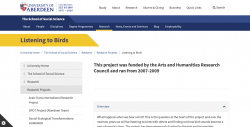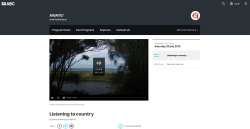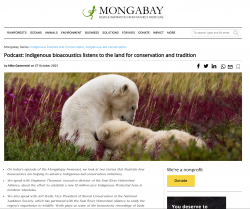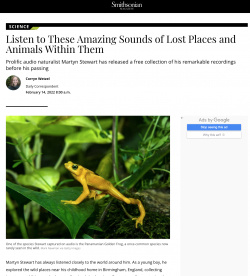Listening to Birds

Type
Audio/Visual
Authors
Category
Projects
[ Browse Items ]
Publication Year
2009
Publisher
University of Aberdeen, United Kingdom
URL
[ private ]
Abstract
What happens when we hear a bird? This is the question at the heart of this project and over the next two years we will be listening to birds with others and finding out how bird sounds become a part of people's lives. The project has been generously funded by the Arts and Humanities Research Council and is based in the Department of Anthropology at Aberdeen.
We want to investigate how people listen to birds because we're fascinated by two subjects. First, we are interested in the relationships between humans and birds and the role that sound plays in this. We wish to understand how bird sounds become important and meaningful to people, for example as being evocative of time, place or season. Second, we want to explore hearing and to consider how people become skilled at differentiating what they hear. How do people learn the skills of listening to, and identifying, bird sounds? And in the first place, how do people come to attend to bird sounds, rather than ignoring them? Through addressing these questions we aim to explore the relationship between vision and hearing, something critical to understanding what happens when we hear a bird. For example, we intend to consider how hearing a bird might be different to seeing it. How does seeing influence what we hear and how we hear it? What is the relationship between a bird as an object and the sounds that it makes?
The project also aims to show how important birds are to people in many different ways. Birds are ubiquitous and even in cities the sound of birds rises above the noise of traffic and industry. Hearing birds is an experience that people almost everywhere can and do have. Some birds are much more easily heard than seen and birds are so diverse and their identification, both by sight and sound, so complex that they represent an ideal case for a study of perception and classification in an immense variety of situations.
So over the next two years, we'll be examing all of these themes through various kinds of anthropological research. To gain an understanding of how people develop skilled hearing we're investigating how people learn bird sounds. We'll teach bird sound identification to individual volunteers around Aberdeen, with a particular focus on the role of vision and technology in learning sounds. We also hope to learn a lot about how to recognise bird sounds ourselves, through research in both Britain and Brazil.
We shall aslo explore how bird sounds become important and meaningful, revealing, evocative and significant to different groups and how different interests influence the ways that bird sounds are perceived and identified. We'll be investigating how people, both in northeast Scotland and elsewhere, incorporate bird sounds into their lives. Participants will be interviewed and invited to keep bird sound diaries noting their interactions and feelings. Other plans include a study of interactions between domestic aviary birds and their keepers, focusing on how personal relationships develop between birds and people through sound, and an exploration of how composers and musicians incorporate and are influenced by bird vocalisations. Finally, we're interested in how scientists recognise, record and analyse bird sounds and their taxonomic and ethological significance.
During the two years of the project, a blog will keep you up to date with news, thoughts and findings and we're also keen for people, wherever they are in the world, to tell us about their experiences of listening to birds. You can contribute directly through the website or contact us by email or telephone. We look forward to hearing from you and to hearing birds with you.
We want to investigate how people listen to birds because we're fascinated by two subjects. First, we are interested in the relationships between humans and birds and the role that sound plays in this. We wish to understand how bird sounds become important and meaningful to people, for example as being evocative of time, place or season. Second, we want to explore hearing and to consider how people become skilled at differentiating what they hear. How do people learn the skills of listening to, and identifying, bird sounds? And in the first place, how do people come to attend to bird sounds, rather than ignoring them? Through addressing these questions we aim to explore the relationship between vision and hearing, something critical to understanding what happens when we hear a bird. For example, we intend to consider how hearing a bird might be different to seeing it. How does seeing influence what we hear and how we hear it? What is the relationship between a bird as an object and the sounds that it makes?
The project also aims to show how important birds are to people in many different ways. Birds are ubiquitous and even in cities the sound of birds rises above the noise of traffic and industry. Hearing birds is an experience that people almost everywhere can and do have. Some birds are much more easily heard than seen and birds are so diverse and their identification, both by sight and sound, so complex that they represent an ideal case for a study of perception and classification in an immense variety of situations.
So over the next two years, we'll be examing all of these themes through various kinds of anthropological research. To gain an understanding of how people develop skilled hearing we're investigating how people learn bird sounds. We'll teach bird sound identification to individual volunteers around Aberdeen, with a particular focus on the role of vision and technology in learning sounds. We also hope to learn a lot about how to recognise bird sounds ourselves, through research in both Britain and Brazil.
We shall aslo explore how bird sounds become important and meaningful, revealing, evocative and significant to different groups and how different interests influence the ways that bird sounds are perceived and identified. We'll be investigating how people, both in northeast Scotland and elsewhere, incorporate bird sounds into their lives. Participants will be interviewed and invited to keep bird sound diaries noting their interactions and feelings. Other plans include a study of interactions between domestic aviary birds and their keepers, focusing on how personal relationships develop between birds and people through sound, and an exploration of how composers and musicians incorporate and are influenced by bird vocalisations. Finally, we're interested in how scientists recognise, record and analyse bird sounds and their taxonomic and ethological significance.
During the two years of the project, a blog will keep you up to date with news, thoughts and findings and we're also keen for people, wherever they are in the world, to tell us about their experiences of listening to birds. You can contribute directly through the website or contact us by email or telephone. We look forward to hearing from you and to hearing birds with you.
Description
https://www.abdn.ac.uk/socsci/research/birdsong.php#panel908
Number of Copies
1
| Library | Accession No | Call No | Copy No | Edition | Location | Availability |
|---|---|---|---|---|---|---|
| Main | 185 | 1 | Yes |




